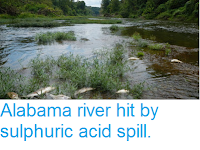At least twenty three people have been killed, about twenty more are missing, and more than fifty people injured after a series of tornadoes touched down in the community of Beauregard in Lee County Alabama, on Sunday 3 March 2019, with other storms reported to have caused damage across eastern Alabama and neighbouring parts of Georgia. At least two to the fatalities were children, with the youngest victim reported to have been only six years old.
Emergency services in the community of Beauregard in Lee County, Alabama, following a series of tornado strikes on Sunday 3 March 2019. AP.
Tornadoes are formed by winds within large thunder storms called super
cells. Supercells are large masses of warm water-laden air formed by hot
weather over the sea, when they encounter winds at high altitudes the
air within them begins to rotate. The air pressure will drop within
these zones of rotation, causing the air within them so rise, sucking
the air beneath them up into the storm, this creates a zone of rotating
rising air that appears to extend downwards as it grows; when it hits
the ground it is called a tornado.
Tornadoes can occur anywhere in the world, but are most common, and most
severe, in the area of the American mid-west known as 'Tornado Ally',
running from Texas to Minnisota, which is fuelled by moist air currents
from over the warm enclosed waters of the Gulf of Mexico interacting
with cool fast moving jet stream winds from the Rocky Mountains. Many
climatologists are concerned that rising temperatures over the Gulf of
Mexico will lead to more frequent and more severe tornado events.
Simplified diagram of the air currents that contribute to tornado formation in Tornado Alley. Dan Craggs/Wikimedia Commons/NOAA.
See also...
Follow Sciency Thoughts on Facebook.








